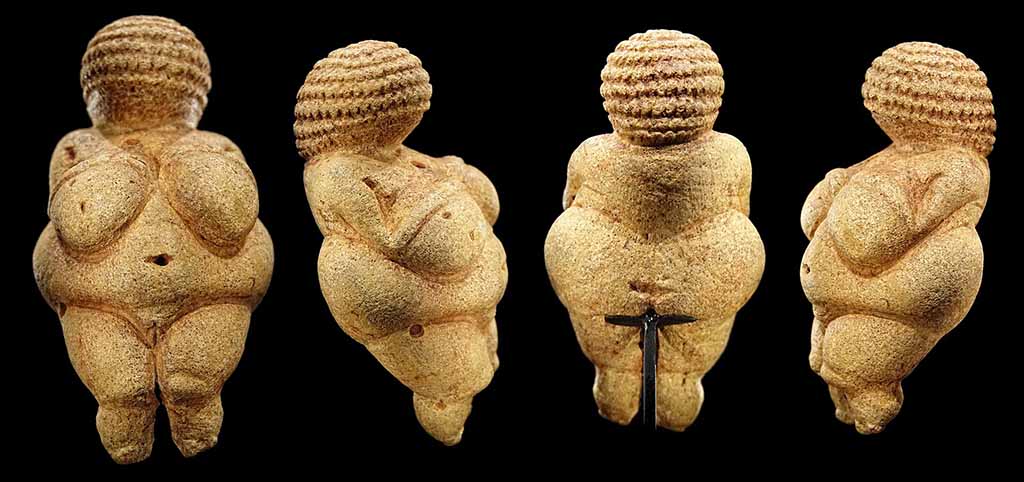The great goddess myth is a theory that powerful goddesses was worshiped by many different human groups during the Paleolithic and Neolithic periods. It’s based on the discovery of figurines and engravings of female figures from all over the world, as well as the presence of goddess figures in many cultures.
The figurines and engravings date back 30,000 years, and they are found in a wide variety of cultures. Some of the figurines are quite crude, without limbs or facial features while others are more stylised. But they all share one common feature: they depict women in positions of power and authority.
Some historians have suggested that these ages may have been matrifocal (woman-centred) or even matriarchal (women ruled) and probably characterised by more equal gender relations, less violence, and a greater unity with the natural order.
For example, the famous figurine of the Venus of Willendorf shows a woman with a large, pregnant belly and exaggerated breasts is usually interpreted as a symbol of fertility and abundance. Another figurine, the Venus of Malta, shows a woman with a bird’s head, perhaps representing the goddess of the sky or the earth.
Hesiod’s Theogony, the Greek myth of the creation of the gods tells of the creation of the first woman, Pandora, who introduced disease, suffering, and death into the world. The Theogony is an account of how Zeus came to be the chief god and Hera, who was probably at one time an important goddess is reduced to a jealous wife. The relationship between Wotan and Fricka in Norse mythology is similar. But in both these accounts, the primary agent of creation is Gaia or Erda, Mother Earth.
The primeval goddess appears in many ancient cultures. In Estonia Ma Emma was worshiped as the source of all life. The original inhabitants of Ireland were Tuatha de Danu, ‘People of the Goddess Danu.’ And in the Enuma Elish, the Babylonian creation myth, the first generation of gods and goddesses were born from Tiamat; later, the whole world and the heavens are created from her body.
Myths from all over the world highlight the role of the goddess as either the creator or an important cultural figure. In a Vietnamese myth, the goddess Au Co comes to explore the newly created earth but is prevented from returning to heaven. As she weeps at her fate, her tears make rivers of water that support plant life. A dragon prince finds her, changes himself into a young man, and marries her, and they have many human children. When the prince is summoned to succeed his father as emperor of the sea, Au Co is left as supreme deity of the planet.
According to the Romanian historian Mircea Eliade, all important skills and techniques for survival on earth were attributed to gods or goddesses. In a Brule Sioux myth, a goddess called White Buffalo Woman teaches the people how to live properly. When she leaves, the buffalo return to enable the people to survive. ‘The four ages of creation are in me,’ says White Buffalo Woman. ‘I am the four ages.’
In a myth from Zimbabwe, a god named Mwetsi is given Massassi (the Morning Star) to be his wife for two years on earth, and she gives birth to vegetation. Massassi is then replaced by Morongo (the Evening Star), who gives birth to animals and humans. When he tries to mate with her once more, the snake with which she now sleeps bites him, and he sickens and dies. In this story, the goddess plays all of her roles: virgin, seductress, mother, and crone. And her consort must die and be replaced by a new one to guarantee fertility for another year.
There is still much that we do not know about the role of women in prehistory. However, the evidence that we do have suggests that the great goddess was an important figure in many cultures around the world. And the myths and legends that have survived from these cultures offer a glimpse into a time when women were revered and respected for their power and wisdom.
- Gaia (Greek): The Earth Mother, the primary agent of creation in Greek mythology.
- Cybele (Greek): The Great Mother, a goddess of fertility and the mountains.
- Isis (Egyptian): The mother goddess, a goddess of fertility, magic, and protection.
- Aphrodite (Greek): The goddess of love, beauty, and pleasure.
- Kali (Hindu): The goddess of death, destruction, and time.
- Tiamat (Mesopotamian): The primordial goddess of the ocean, chaos, and creation.
